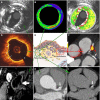Imaging Cardiovascular Calcification
- PMID: 29954746
- PMCID: PMC6064897
- DOI: 10.1161/JAHA.118.008564
Imaging Cardiovascular Calcification
Keywords: atherosclerosis; calcification; imaging.
Figures




References
-
- Hartiala O, Magnussen CG, Kajander S, Knuuti J, Ukkonen H, Saraste A, Rinta‐Kiikka I, Kainulainen S, Kǎhǒnen M, Hutri‐Kǎhǒnen N, Laitinen T, Lehtimǎki T, Viikari JS, Hartiala J, Juonala M, Raitakari OT. Adolescence risk factors are predictive of coronary artery calcification at middle age: the Cardiovascular Risk in Young Finns Study. J Am Coll Cardiol. 2012;60:1364–1370. - PubMed
-
- Abdelbaky A, Corsini E, Figueroa AL, Fontanez S, Subramanian S, Ferencik M, Brady TJ, Hoffmann U, Tawakol A. Focal arterial inflammation precedes subsequent calcification in the same location: a longitudinal FDG‐PET/CT study. Circ Cardiovasc Imaging. 2013;6:747–754. - PubMed
Publication types
MeSH terms
Grants and funding
LinkOut - more resources
Full Text Sources
Other Literature Sources
Medical

